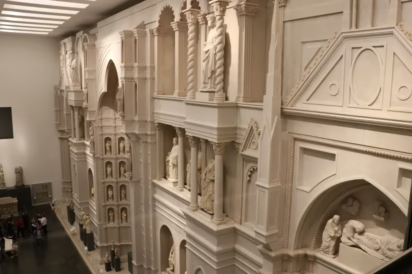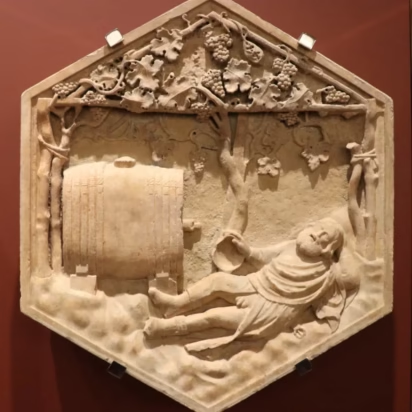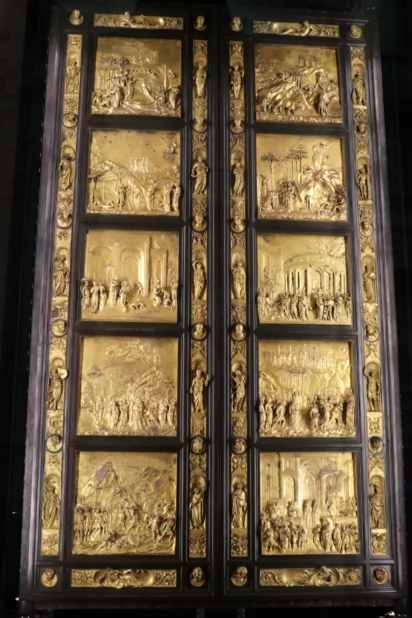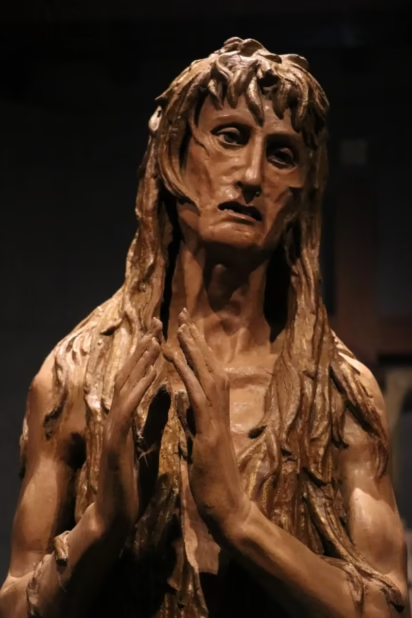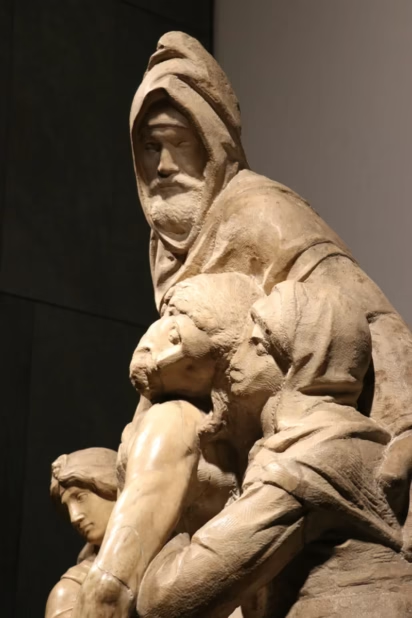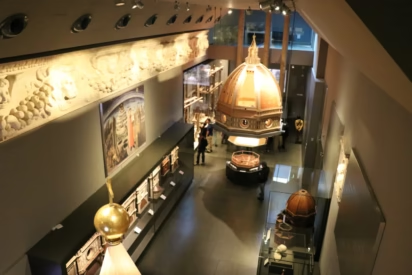Visit the Museo dell’Opera del Duomo di Firenze (Museum of the Works of the Cathedral) in Florence to see the original art, sculptures, and treasury of the cathedral, baptistry, and campanile.

The Museo dell’Opera del Duomo di Firenze (Florence Cathedral Museum) behind the church is home to many of the original artworks from the cathedral, campanile, and baptistry. The sculptures are particularly important and include many by Donatello and a large number of works designed by Giotto and Pisano. Further highlights are the original doors of the baptistery, models used for the building of the cupola, and designs for the western facade. All three Duomo site passes include admission to the museum. There are no museum-only tickets. Guided tours often include the baptistery and climbing the dome of the cathedral.
Museo dell’Opera del Duomo in Florence
The Museum of the Works of the Cathedral has in addition to many sculptures and the bronze doors from the baptistry all the typical items found in a cathedral museum. The number of items on display is not particularly big but consistently of very high artistic quality. Along with the main attractions described below, expect to see a variety of religious accouterments, vestments, monstrances, reliquaries, paintings, and anthem books — many from the early 16th century
Odds and ends include fragments of recycled Roman stones and art, as well as sections of the large baptismal font removed from the baptistery.
The entrance hall to the museum is in the space where Brunelleschi planned the construction of the cupola and Michelangelo sculpted David. This most famous work destined for the Duomo never made it up to the buttresses of the apsis. In contrast to the other original sculptures, David is not here but rather in the nearby Galleria dell’ Accademia.
Highlights in the Duomo Museum in Florence
The top attractions of the Museo dell’Opera del Duomo di Firenze (Florence Cathedral Museum) include:
- All three sets of bronze doors of the Baptistry
- Sculptures of the original Gothic Facade
- Mary Magdalene wood-carved statue by Donatello
- Marble Pieta with a self-portrait by Michelangelo
- Original reliefs and sculptures from Giotto’s campanile
- Models and designs of the cupola and western facade
- Treasury including the silver altar from the baptistery
Hall of Paradise in the Duomo Museum in Florence
The Sala del Paradiso / Hall of Paradise is named after the space between the baptistery and the church — traditionally referred to as paradise. In this hall, visitors see the original sculptures of the Gothic western facade of the cathedral and the original bronze doors of the baptistery.
The three original sets of bronze doors of the baptistery and the original sculptures located above these doors are displayed here. All three sets are art-historical highlights for their time of creation but Ghiberti’s Renaissance doors of Old Testament scenes described by Michelangelo as suitable to be the gates to paradise are among the masterpieces of Western art.
→ See Visit the Baptistry in Florence for a more detailed description of these doors
On the opposite wall, the original Gothic facade was recreated showing the original statues in situ. This facade was never completed and only built to around a third of the originally planned height, as is shown here. This facade was torn down in the late 16th century and only replaced in 1887. Most of the statues are 14th or early 15th century.
Some of the highlights include the early 15th-century statues of the evangelists: John by Donatello, Mark by Niccolo di Pietro Lamberti, Luke by Nanni di Banco, and Matthew by Bernardo Ciuffagni. From the same period are the doctors of the church by Lamberti and Tedesco.
Donatello’s Wood-Carved Mary Magdalene
One of the most remarkable works in the museum is the sculpture of the Penitent Mary Magdalene that Donatello carved around 1455 from white poplar — a masterpiece quite different from the more famous bronze David and marbles by Donatello now on display in the Bargello Museum.
According to Catholic tradition, Mary Magdalene spent years in the desert as a hermit. This sculpture shows her deformed by fasting but at peace through prayer. The emaciated Mary stands 185 cm tall. The sculpture was originally painted or at least partly gilded. It remained in the baptistry until the 1960s.
The early 14th-century crucifix in the same hall was also in the baptistry and is attributed to Giovanni di Balduccio.
Pieta Bandini by Michelangelo
In the adjacent room is the penultimate marble sculpture by Michelangelo. In this Bandini Pieta (The Deposition or The Lamentation over the Dead Christ) the body of Christ is carried by Mary Magdalene and Mary, Mother of Christ. Behind them is a self-portrait of Michelangelo as Nicodemus.
Michelangelo worked on the sculpture between 1547 and 1555 and probably intended it for his own tomb. However, he partly destroyed it due to a flaw in the marble and disposed of the work, still damaged, prior to his own death. Francesco Bandini had the work restored by Tiberio Calgani, who reattached some limbs and fingers. However, he changed Mary Magdalene’s facial expression from anguish to a more distant look quite out of character with the rest of the work.
Cosimo III de’ Medici bought the restored work in 1671 for the crypt of the Basilica of San Lorenzo. It was only moved into the duomo a century later.
Gallery of the Campanile

The large Galleria del Campanile (Gallery of the Bell Tower) on the first floor contains the original 16 sculptures and 54 reliefs from Giotto’s bell tower. Although Giotto probably designed some of the reliefs, most are attributed to his follower Andrea Pisano and his son Nino.
Several of the life-sized statues are by Donatello including the bald prophet Habakkuk (often referred to as the Zuccone or dimwit due to his bald head) and the prophet Jeremiah. His beardless prophet, originally staring at the cupola, probably depicted Brunelleschi. (Brunelleschi’s death mask is on display in a nearby room.)
Gallery of the Cupola of the Duomo di Firenze
The Galleria della Cupola is dedicated to the building process and the competition for the design of the dome. It includes some models and instruments used in the building of the dome. Videos explain the ingenuity of Brunelleschi’s double-dome design.
Also on display are models for the lantern and rejected suggestions on how to decorate the drum. A section shows the designs, plans, and paintings for the facade in the late 19th century. Renaissance models suggested in the 1600s are displayed one floor higher.
Further displays include stained glass windows designed by Ghiberti, Donatello, Paolo Uccello, and Andrea del Castagno from 1436 and the monumental corniche erected on the southeast side of the drum of the duomo that Michelangelo described as cricket cages.
Visitors may see the cupola and especially the southern apse close-up from an open-air terrace on the top floor of the museum.
Treasury of the Duomo Museum in Florence

A highlight of the Sala del Tesoro is the monumental cross and the altar from the baptistery that was made using 250 kg of silver. The altar is the work of several generations of artists from 1366 to 1483. The artistic levels are uneven but the recently restored panels are fascinating.
As the main altar for the baptistery, it not surprisingly shows events from the life of John the Baptist. It covers his full biblical history from the annunciation to Zacharias and the visitation to the grizzly end. The decapitation of John by Andrea del Verrocchio shows intricate detailing in the armor of the soldiers. The executioner inexplicably works naked but for a tight pair of hot pants.
The scene of the presentation of the head on a platter at the banquet of Herod by Antonio di Salvi Salvucci also shows fine details and a better understanding of the rules of perspective than the earlier panels. The sculpture of John the Baptist at the center front of the altar is by Michelozzo, the pupil of Ghiberti and later collaborator of Donatello.
Several historic liturgical vestments are also displayed. Particularly note the embroideries on the vestment with 27 panels of scenes from the life of John the Baptist by Antonio del Pallaiolo.
Visit the Duomo Museum in Florence

The main ticket office for the Duomo is no longer in the museum but rather near the baptistery. Tickets for all sites are available here including time-slot reservations for climbing Brunelleschi’s cupola and the campanile. However, it is best to buy online from the official website — ticket prices and availability are the same.
The museum is usually open daily from 9:00 to 19:00 but closed on the first Tuesday of each month.
The museum and baptistry are included in all the combination ticket passes — museum-only tickets are not available. Guided tours often include further cathedral sites so only concentrate on the top items in the museum.
→ See 2025: Florence New Opening Hours of Top Sights, Museums, and Churches for the latest information and current opening hours.
More on the Duomo in Florence
- Visit the Cathedral of Florence (Duomo di Firenze)
- Visit the Baptistry (Battistero)
- Climb Giotto’s Campanile
- Climbing the Brunelleschi Campanile
- Museo dell’Opera del Duomo (Museum of the Works of the Cathedral)
- Tickets and Opening Hours for Visiting the Duomo Sights in Florence
- Current Opening Hours for Top Sights in Florence
- Guided Tours of the Duomo Sights
- More Photos on Flickr
More Articles on Florence Sights
The high season in Florence is increasingly long: Easter, May, July, August, and the Christmas holidays are especially busy. November and January to mid-March are the only quiet months, except for the February school holiday week. Plan and book time-slot reservation tickets and tours when available in advance — the Accademia and the Uffizi are again sold out weeks in advance. Top sights are quieter directly at opening time or in the late afternoon.
→→ Opening hours for top sights in 2025 — most sights have long hours but advance time-slot reservations are always sensible.
- Tips on Buying Tickets for the Uffizi Museum
- Tips on Buying Skip-the-Line Tickets for the Accademia (Michelangelo’s David)
- See Michelangelo’s David in the Galleria dell’ Accademia
- Visit the Duomo sights: Cathedral (Duomo), Baptistery (Battistero), Bell Tower (Campanile), Dome (Cupola), Museum (Museo), and Tickets + Opening Hours
- Visit the Bargello Museum of Sculpture (Donatello’s Davids)
- Visit San Marco Museum to see the frescoes and altarpieces painted by Fra Angelico.
- Visit Santa Maria Novella Church and Museum to see medieval and Renaissance Art.
- Visit Santa Croce for Giotto Frescoes and Michelangelo’s Grave
- San Lorenzo complex: Visit the Basilica for Renaissance Art, See the Laurentian Medici Library by Michelangelo, and Visit the Medici Chapels (Michelangelo Statues)
- Visit the Orsanmichele Church and Museum with sculptures.
- Save on Sightseeing in Florence with the Firenze Card (again available but not including transportation or the Duomo sights, or consider the Turbopass Florence City Pass that includes online timeslot reservations for both the Uffizi and Accademia.
- Travel to Pisa to see the Field of Miracles and the Leaning Tower of Pisa.
- Visit the magnificent Romanesque-Gothic cathedral in nearby Siena.
- Save on top Italian designer fashion at The Mall Factory Outlet Stores.
Florence Resources
- The official website of the Firenze Tourist Office is a bit cumbersome but has very useful information. Especially the pdf (alternative link) with the opening hours of all major sights. Unfortunately, it is only available for the current month but it is the second last line on opening hours — the final say is the guard at the door, NOT the ticket window!
- Get Your Guide offers tours of all major sights while Tiqets sells online tickets for many top sights in Florence.
- Book luggage storage online and explore Florence more easily on foot.
- Trainline is good for booking online train tickets in Italy and most of Europe.
